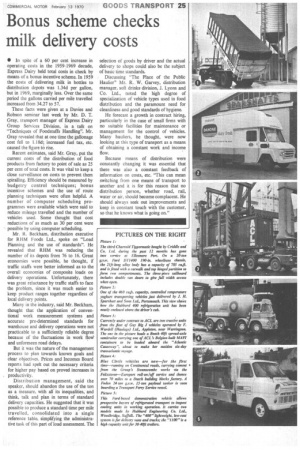Bonus scheme checks milk delivery costs
Page 27

If you've noticed an error in this article please click here to report it so we can fix it.
• in spite of a 60 per cent increase in operating costs in the 1959-1969 decade, Express Dairy held total costs in check by means of a bonus incentive scheme. In 1959 the costs of delivering milk in bottles to distribution depots was 1.34d per gallon, but in 1969, marginally less. Over the same period the gallons carried per mile travelled increased from 34.27 to 57.
These facts were given at a Davies and Robson seminar last week by Mr. D. T. Gray, transport manager of Express Dairy Group Services Division, in a talk on -Techniques of Foodstuffs Handling". Mr. Gray revealed that at one time the gallonage cost fell to 1.18d; increased fuel tax, etc. caused the figure t6 rise.
Recent estimates, said Mr. Gray, put the current costs of the distribution of food products from factory to point of sale as 25 per cent of total costs. It was vital to keep a close surveillance on costs to prevent them spiralling. Efficiency should be measured by budgetry control techniques; bonus incentive schemes and the use of route planning techniques were often helpful. A number of computer scheduling programmes were available which were said to reduce mileage travelled and the number of vehicles used. Some thought that cost reductions of as much as 30 per cent were possible by using computer scheduling.
Mr. R. Beckham, distribution executive for RI-1M Foods Ltd., spoke on "Load Planning and the use of standards". He revealed that RHM was reducing the number of its depots from 76 to 16. Great economies were possible, he thought, if traffic staffs were better informed as to the overall economies of composite loads on delivery operations. Unfortunately, there was great reluctance by traffic staffs to face the problem, since it was much easier to keep product ranges together regardless of local delivery points.
Many in the industry, said Mr. Beckham, thought that the application of conventional work measurement systems and accurate pre-determined standards for warehouse and delivery operations were not practicable to a sufficiently reliable degree because of the fluctuations in work flow and unforeseen road delays.
But it was the nature of the management process to plan towards known goals and clear objectives. Prices and Incomes Board reports had spelt out the necessary criteria for higher pay based on proved increases in productivity.
Distribution management, said the speaker, should abandon the use of the ton as a measure, with all its inequalities, and think, talk and plan in terms of standard delivery capacities. He suggested that it was possible to produce a standard time per mile travelled, consolidated into a single reference table, simplifying the administradve task of this part of load assessment. The selection of goods by driver and the actual delivery to shops could also be the subject of basic time standards.
Discussing "The Place of the Public Haulier" Mr. K. W. Garvey, distribution manager, soft drinks, division, J. Lyons and Co. Ltd., noted the high degree of specialization of vehicle types used in food distribution and the paramount need for cleanliness and good standards of hygiene.
He forecast a growth in contract hiring, particularly in the case of small firms with no suitable facilities for maintenance or management for the control of vehicles. Many hauliers, he thought, were now looking at this type of transport as a means of obtaining a constant work and income flow.
Because Means of distribution were constantly changing it was essential that there was also a constant feedback of information on costs, etc. "This can mean switching from one means of transport to another and it is for this reason that no distribution person, whether road, rail, water or air, should become complacent. He should always seek out improvements and keep in constant touch with the customer, so that he knows what is going on."




































































